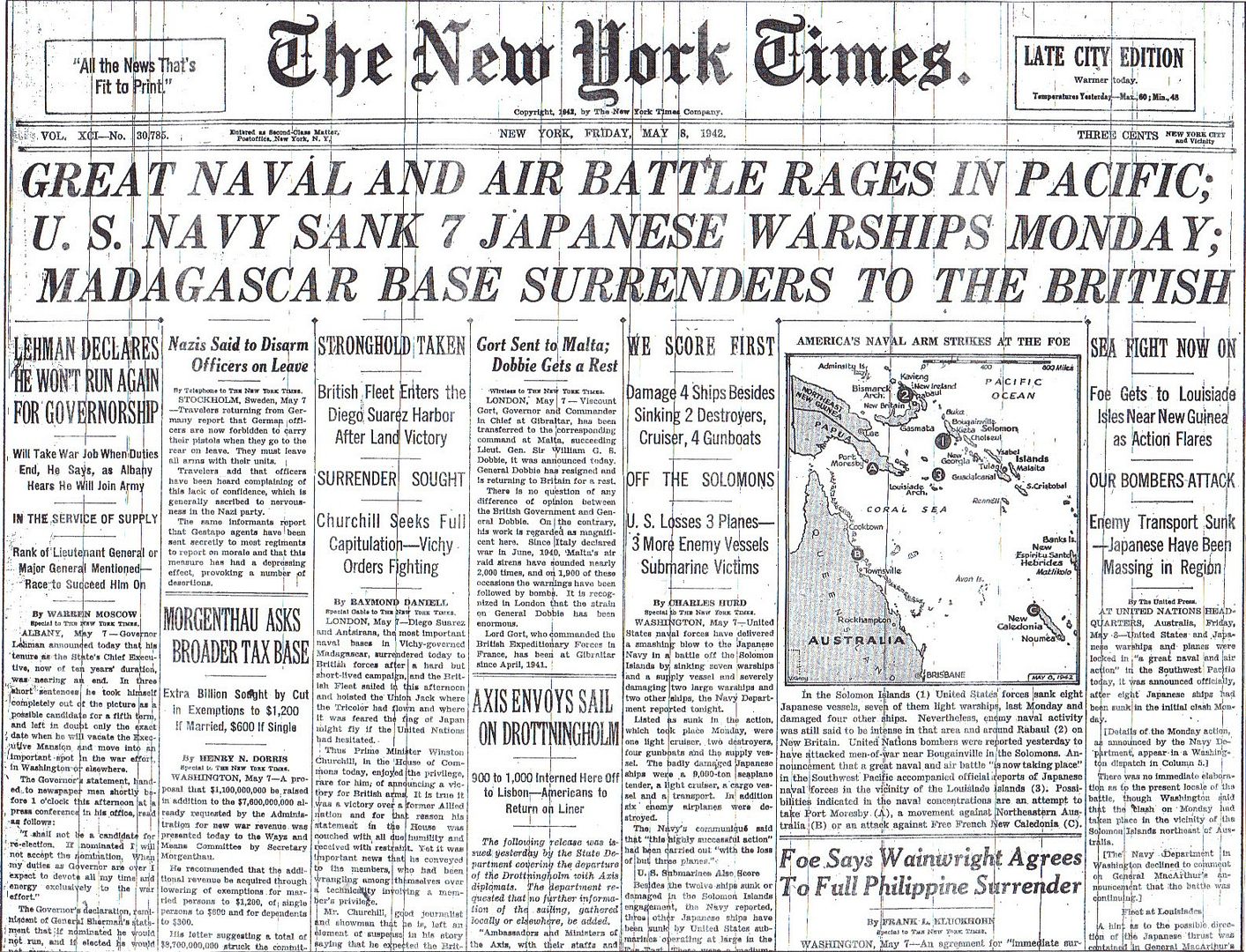
Posted on 05/08/2012 4:22:05 AM PDT by Homer_J_Simpson

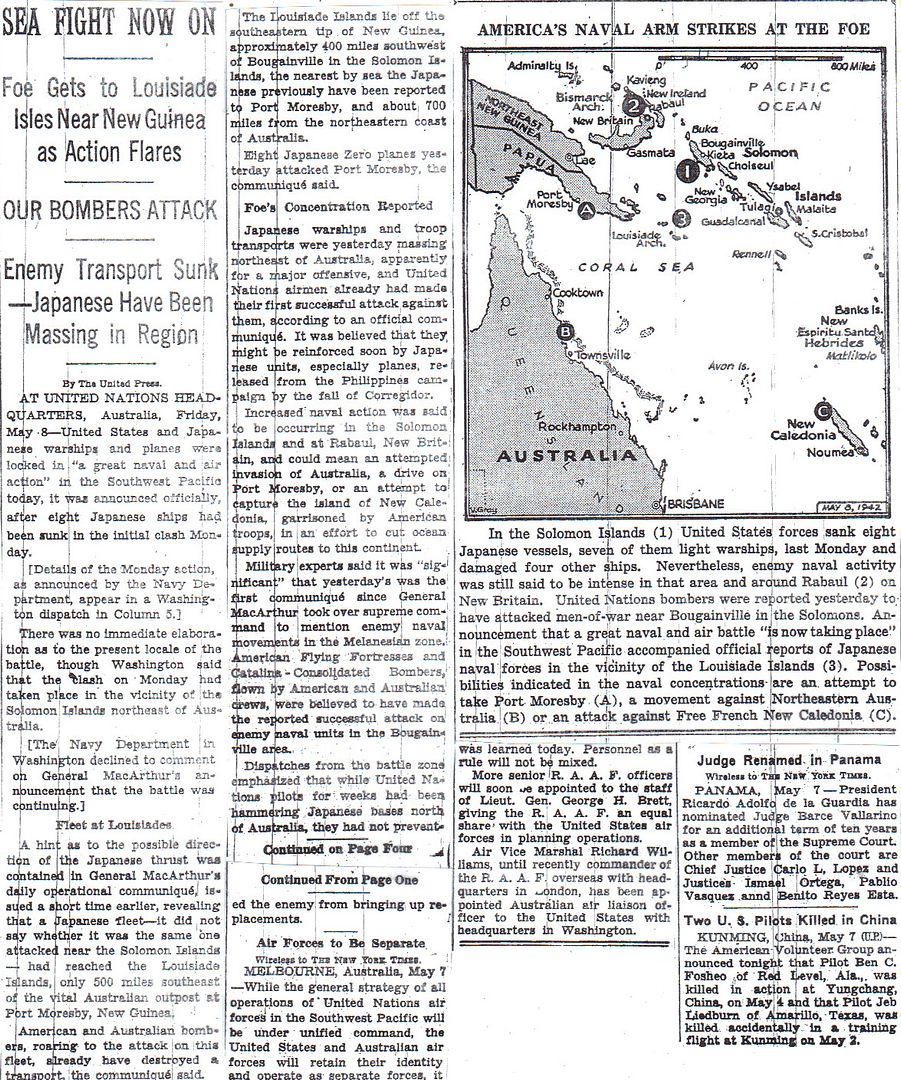
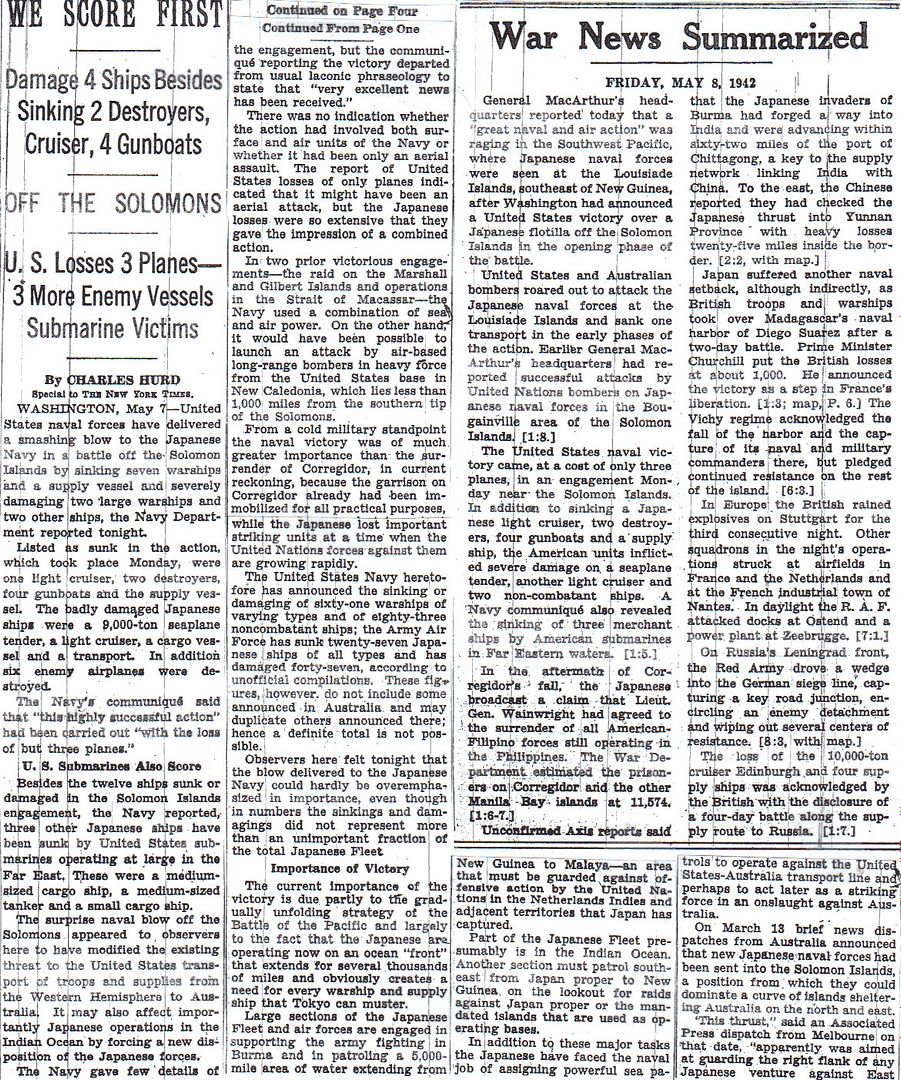
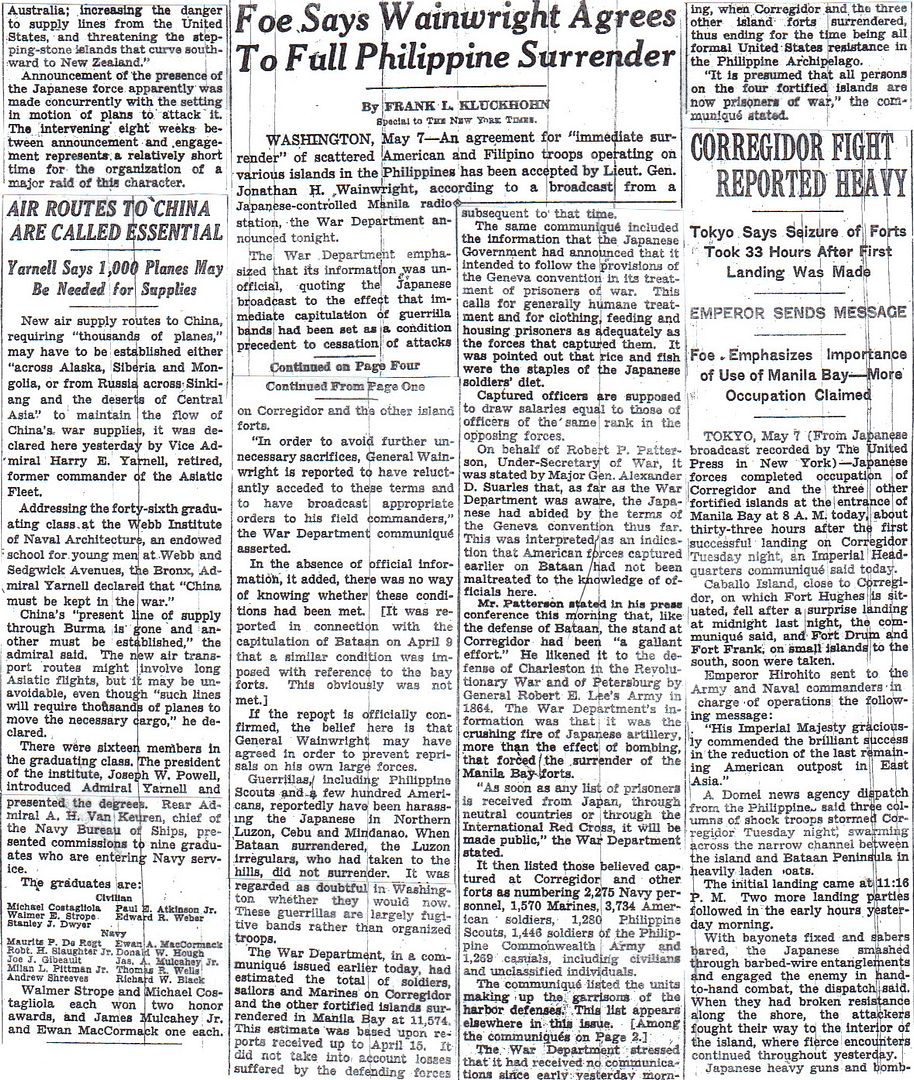
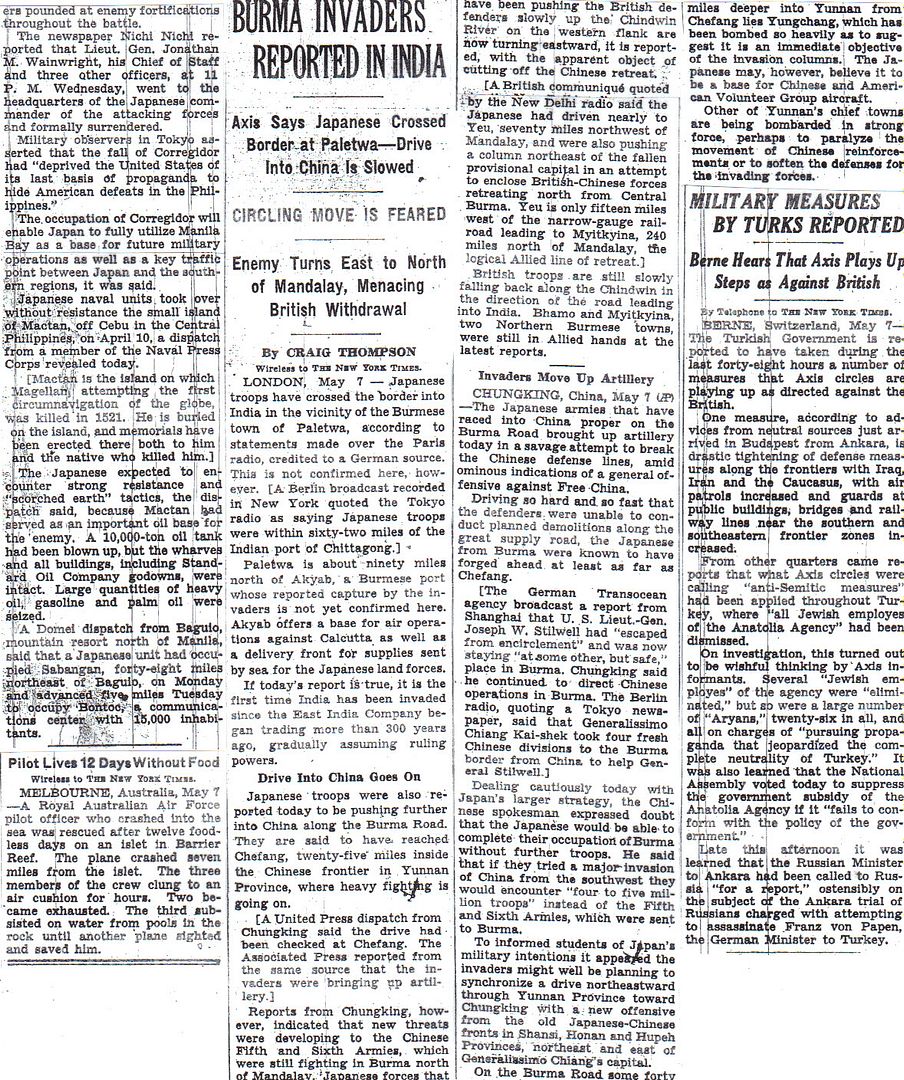


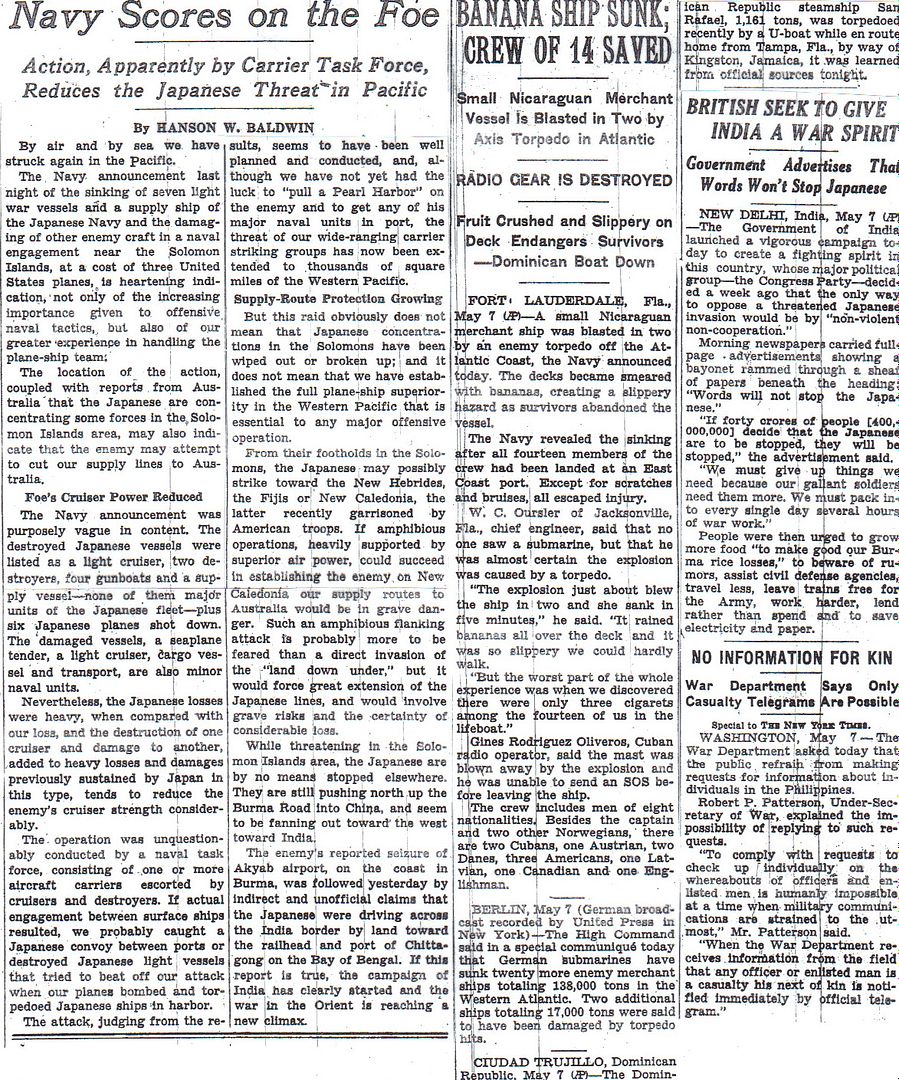
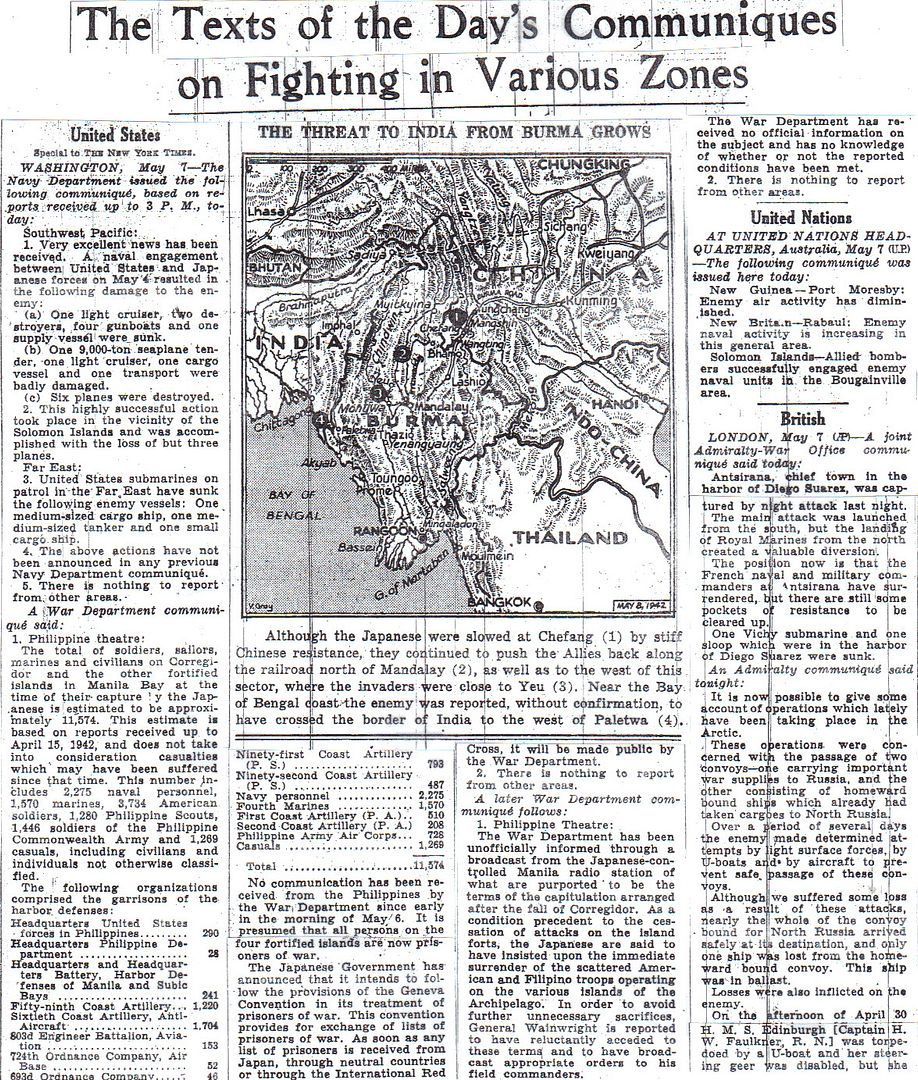
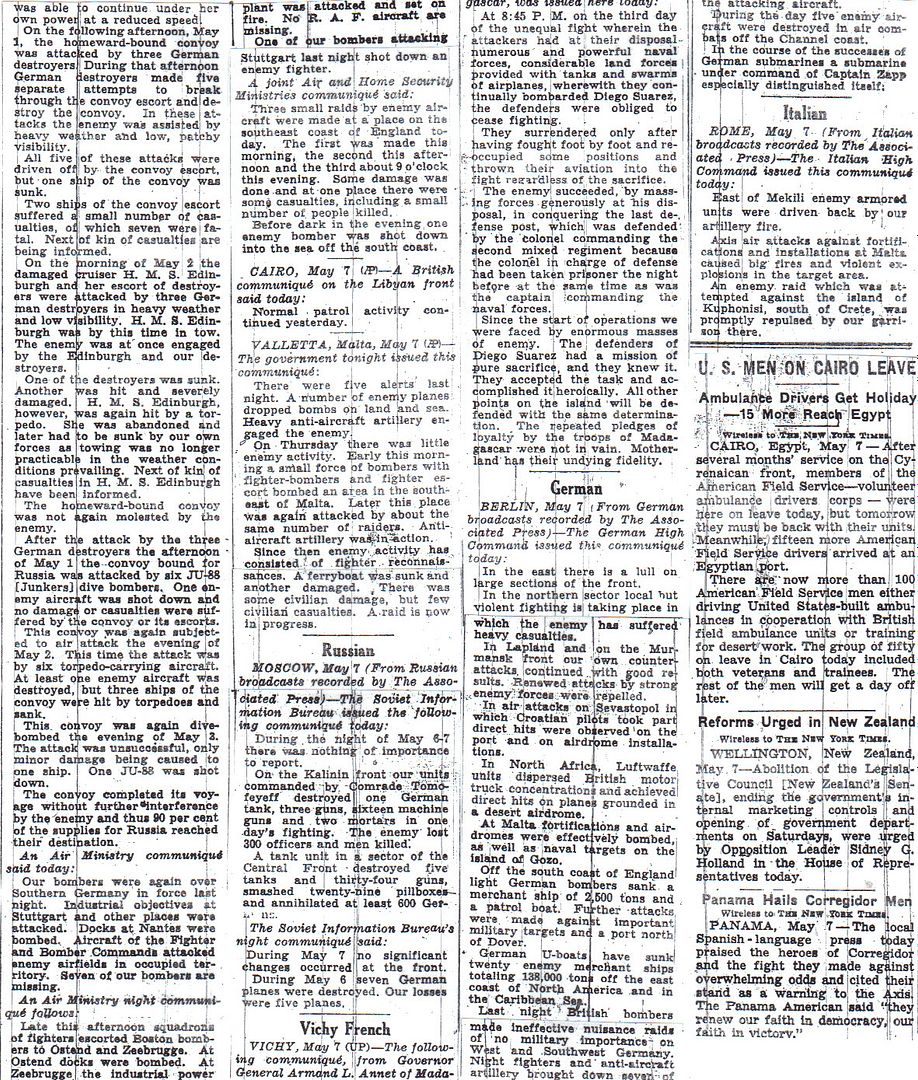
http://www.onwar.com/chrono/1942/may42/f08may42.htm
Carrier battle in the Coral Sea
Friday, May 8, 1942 www.onwar.com
Japanese recon photo of the US fleet engaged [photo at link]
In the Coral Sea... Both the Japanese and the American fleets become aware of each others positions due to aerial reconnaissance. In the battle that follows, the USS Lexington is badly damaged and abandoned. (She will late be sunk by an American destroyer) The USS Yorktown is also hit. On the Japanese side, the Shokaku is seriously damaged. Of major importance is the loss of trained pilots on the Japanese side, as they take severe aerial losses. The battle is noteworthy for several reasons. The Japanese are forced to abandon their attack on Port Moresby, the first real stumbling block in their expansion. It is also the first time that a naval battle has taken place without visual contact between the main combatants. The damage done to the ships was achieved by aircraft launched from carriers and not by naval guns.
On the Eastern Front... The German springtime offensives begins with the 22nd Panzer Division of the 11th Army attacking the Kerch Peninsula in the Crimea.
http://homepage.ntlworld.com/andrew.etherington/frame.htm
May 8th, 1942
UNITED KINGDOM: London: The war cabinet orders a new offensive in the Libyan desert.
The British Foreign Office issued a statement announcing that the British commanders of the troops who took Madagascar immediately informed the French authorities that Madagascar would remain French and would be restored to French sovereignty after the war.
ASW trawler HMS Whiting commissioned. (Dave Shirlaw)
FRANCE: Paris: Capitaine Paul Sézille, head of the Gestapo funded Institut des Questions Juives tasked with propagating anti-Semitism, writes to Dannecker complaining that Jewish children in schools, notably in the Lycée Condorcet, “which had always been a Jewish lycée,” and in the lycée Jules Ferry, had not yet been separated out. French porters, furthermore, had been observed carrying luggage for Jews.
GERMANY: U-539 laid down. (Dave Shirlaw)
U.S.S.R.: The German offensive for 1942, Operation Bustard, opens in Russia in the Crimea led by von Manstein’s 22nd Panzer Division. They aim to recapture the Kerch peninsula.
MEDITERRANEAN SEA: Submarine HMS Olympus carrying 36 passengers (the crews of P.36 P.39, and HMS Pandora) in all 98 persons is mined whilst on the surface off Malta and sinks within 9 minutes. Only 12 survivors manage to swim the 5 or 6 miles to the shore. (Alex Gordon)(108)
INDIAN OCEAN: Submarine FS Monge sunk by destroyers HMS Active and Panther off Diego Suarez. (Dave Shirlaw)
PACIFIC OCEAN: The Battle of the Coral Sea continues with the simultaneous sightings by both sides of each other. Attacks are quickly mounted. The USS Lexington sinks and the USS Yorktown is damaged. The IJN Shokaku is damaged.
At approximately 0830 hours local, a search plane from the aircraft carrier USS Lexington (CV-2) locates the Japanese carrier force consisting of the aircraft carriers HIJMS Shohaku and HIJMS Zuikaku south of San Cristobal Island, Solomon Islands. [San Cristobal Island is 38 miles (61.2 km) southeast of Guadalcanal Island, Solomon Islands.] A carrier strike force is launched by the Americans between 0915 and 0925 hours; the Yorktown Air Group in USS Yorktown (CV-5) launches 30 Douglas SBD Dauntless dive bombers, nine Douglas TBD Devastator torpedo bombers and 14 Grumman F4F Wildcat fighters while the Lexington Air Group in USS Lexington launches 24 SBDs, 12 TBDs and ten F4Fs.
At approximately the same time, the two Japanese aircraft carriers launch a strike force against the Americans.
The Yorktown SBDs locate both Japanese carriers at 1032 hours local but orbit the ships awaiting the arrival of the slower TBDs giving the Japanese time to launch Mitsubishi A6M Navy Type 0 Carrier Fighters, Allied Code Name “Zeke.” By the time the TBDs arrive, the HIJMS Zuikaku is hidden by a rain squall and the Americans attack HIJMS Shokaku. The TBDs attack with torpedoes but all miss while the SBD dive bombers score two hits with 1,000-pound (453.6 kg) bombs. TBDs of the Lexington Air Group attack with torpedoes but fail to hit the ship while four Lexington SBDs score one hit on the ship; only four of the 24 Lexington SBDs locate the target. HIJMS Shokaku is heavily damaged and retires; it takes two months to repair her.
The cost to the USN is nine SBDs, two TBDs and three F4Fs. At 1118 hours local, the Japanese attack force consisting of 18 Nakajima B5N Navy Type 97 Carrier Attack Bombers, Allied Code Name “Kate;” 33 Aichi D3A Navy Type 99 Carrier Bombers, Allied Code Name “Val;” and 18 Mitsubishi A6M “Zeke” fighters arrive over the USN’s carriers. The “Kates” attack USS Lexington with torpedoes and she is struck by two torpedos on her port side. At the same time, “Vals” put three bombs into her, producing a 7 degree list to port and several raging fires. By 1245 hours damage control parties have brought the fires under control and returned the ship to an even keel; making 25 knots, she begins to recover her air group. Then suddenly at 1247, the ship is shaken by a tremendous explosion, caused by the ignition of gasoline vapors below, and again fire rage out of control.
At 1558 hours, the captain secured salvage operations, and ordered all hands to the flight deck. At 1707 hours, he ordered, “abandon ship!” Lexington blazed on, flames shooting hundreds of feet into the air until a destroyer sinks her with two torpedoes.
The USS Yorktown is also attacked by the Japanese formation and managed to avoid eight torpedoes until a bomb from a “Val” penetrated the flight deck and exploded below decks, killing or seriously injuring 66 men. The fires were brought under control and flight operations continued.
In addition to the damage to HIJMS Shokaku, HIJMS Zuikaku’s air group suffers heavy losses estimated at eight “Kates,” 15 “Vals,” and six “Zekes,” preventing the Japanese from using these ships for several months.
The Japanese have won a tactical victory sinking threeUSNships (Lexington, the destroyer USS Sims and the oiler USS Neosho) but the Allies have won a strategic victory by forcing the Japanese to abandon the invasion of Port Moresby, New Guinea thereby keeping the sea lanes between the U.S. and Australia open. The USN also realizes that the number of fighter aircraft on the carriers must be increased to provide adequate protection.
Three U.S. sailors are awarded the Medal of Honor for actions during the Battle of the Coral Sea. Lieutenant John J. Powers, USN, of Bombing Squadron Five (VB-5) in USS Yorktown is awarded the medal posthumously for his attack on HIJMS Shokaku; Lieutenant (jg) William E. Hall, USNR, of Scouting Squadron Two (VS-2) in USS Lexington is awarded his medal for shooting down three Japanese aircraft while flying an SBD; and Lieutenant Milton E. Ricketts, USN, a damage control officer in USS Yorktown, is awarded the medal posthumously for fighting the fires aboard the ship. The citations for their awards may be viewed. (Jack McKillop)
Submarine GRENADIER (SS210) attacks Japanese convoy about 120 miles southwest of Kyushu, Japan and sinks army transport TAIYO MARU, 30 degrees 40 minutes North, 127 degrees 54 minutes East; GRENADIER survives persistent attacks by enemy antisubmarine forces the following day. TAIYO MARU carries to their deaths many technical experts bound for the East Indies to work on resuming oil production. (Denis Peck)(70)
Japanese plans for an attack on Port Moresby, New Guinea. This is the first setback for the Japanese offensive. It is also the first carrier vs. carrier battle in history. Neither of the opposing naval forces will see the other side.
With the sinking of USS Lexington her carrier air group is disbanded. (Jack McKillop)
A stochastic analysis of the battle is here.
COCOS (KEELING) ISLANDS: A mutiny among Commonwealth troops stationed here, results in a Field General Court Martial at which three servicemen are sentenced to death. This mutiny causes the disbandment of the Coastal Battery RGA and is the subject of a book, The Cocos Islands Mutiny by Noel Crusz. (Daniel Ross)
CANADA: Corvette HMCS Matapedia arrived Pictou , Nova Scotia for refit. (Dave Shirlaw)
U.S.A.: Alvin York is commissioned as Major, USA. York, as Sgt York in WWI received the MOH.
78th Pursuit Group (Interceptor) and its three subordinate units, the 82d, 83d and 84th Pursuit Squadrons (Interceptor) (USAAF), moves to San Diego Municipal Airport, California and continues to train for combat with P-38’s and also provide air defence for the west coast. (Jack McKillop)
The motion picture “In This Our Life” is released in the U.S. Directed by John Huston, this drama stars Bette Davis, Olivia de Havilland, George Brent, Dennis Morgan, Billie Burke and Hattie McDaniel with a bit part by Walter Huston. Based on the Ellen Glasgow novel, this film about a dysfunctional family has Davis stealing her sister’s (de Havilland) husband and then drives him to drink. She returns home and continues to disrupt her sister’s life. (Jack McKillop)
Destroyer USS Heermann laid down.
Destroyer USS Gillespie launched.
Submarine USS Guardfish commissioned. (Dave Shirlaw)
ATLANTIC OCEAN: SS Mont Louis (1,905 GRT), Canadian freighter Capt Walter Bowen, Master, torpedoed and sunk off British Guyana in position 08.23N, 058.44W, by U-162, FKpt Jürgen Wattenberg, CO of her crew of 21, 13 were lost. Mont Louis was proceeding independently carrying a load of bauxite ore from Dutch Guyana for transhipment at Port-of-Spain, Trinidad. The ship was struck by a single torpedo late in the evening and sank in less than two minutes. The survivors, including the master, were rescued by a small Nova Scotian schooner and taken to Georgetown, British Guyana.
At 1812, the unescorted and unarmed Ohioan was torpedoed by U-564 about 10 miles off Boynton Beach, Florida, while steaming on a nonevasive course at 14.5 knots. One torpedo struck on the starboard side at the #4 hold and caused the ship to sink by the stern within three minutes, rolling over from starboard to port. The eight officers and 29 crewmen tried to launch two lifeboats, but the first swamped when it touched the water while the second was cut from its falls but did not float. The suction of the sinking ship caused the majority of the casualties of one officer and 14 crewmen. The survivors rescued themselves on six rafts that had floated free and were rescued by the USCG. They were brought to West Palm Beach, where four had to be hospitalized.
SS Torny sunk by U-507 at 26.40N, 86.40W. (Dave Shirlaw)
Battle of the Coral Sea, the first of the great carrier duels fought in the next six months. The battle wound up costing the Japanese a lot more than it appears. Shokaku was badly hurt, almost capsizing on her long trip back to Japan for repairs. She is scratched for Operation MI set for next month. Zuikaku avoided injury, but her air group has been slaughtered. Japanese doctrine had air groups wedded to their carriers, so they scratched Zuikaku from Operation MI too. Of course, had they really wanted to put Zuikaku with the other four carriers, they could have cobbled together an air group. But they didn’t. Contrast this with the US Navy’s crash effort to get Yorktown repaired and out to sea to fight at Midway.
So the real victory of Coral Sea was a month in its realization; with the scratching of Carrier Division 5, the Japanese lost their carrier superiority over the United States Navy for the battle of Midway.
It might also be noted that the Shokaku had not yet even entered dry dock for repairs when the Battle of Midway was fought. “What's the hurry, it's not like there's a war on or anything.”
IJN Shokaku: Tabular Record of Movement:
One theory has it that the Japanese could have made Zuikaku a “fighter carrier” with the assignment to provide a CAP for the fleet. The Japanese would later do exactly that with Zuiho as the CAP carrier for Shokaku and Zuikaku in the Battle of Santa Cruz. The Japanese knew the importance of a heavy CAP over their fleet by the number of fighters they had aloft at Midway. The problem was that their carriers could not spot aircraft for a strike while also conducting fleet defense. Having one carrier with the capacity of Zuikaku concentrating on the CAP frees up the other four for strike operations.
But, it goes to show that the Japanese were overconfident.
Carrier Division 5, while the newest in the Kido Butai, was also its strongest. They alone had the air assets that equaled or surpassed American carriers of the time in number. They were also the only Japanese carriers afloat that equalled ours in tonnage, and they were capable of operating at higher speeds than Carrier Division 1[AKAGI and the even slower KAGA].
And the failure of Japan to graduate Naval aircrews in adequate numbers to replace those lost will be a problem they never address successfully [along with failing to rotate pilots for instructor duties, much like their German Allies], and one which will lead from Midway to the Great Marianas Turkey Shoot in the blink of an eye.
http://www.history.navy.mil/photos/events/wwii-pac/coralsea/cs-5.htm
Battle of the Coral Sea, 7-8 May 1942
Events of 8 May 1942
Before dawn on 8 May, both the Japanese and the American carriers sent out scouts to locate their opponents. These made contact a few hours later, by which time the Japanese already had their strike planes in the air. The U.S. carriers launched theirs’ soon after 9AM, and task force commander Rear Admiral Frank Jack Fletcher turned over tactical command to Rear Admiral Aubrey W. Fitch, who had more carrier experience. Each side’s planes attacked the other’s ships at about 11AM. At that time the Japanese were partially concealed by thick weather, while the Americans were operating under clear skies.
Planes from USS Yorktown hit the Shokaku, followed somewhat later by part of USS Lexington’s air group. These attacks left Shokaku unable to launch planes, and she left the area soon after to return to Japan for repairs. Her sister ship, Zuikaku, was steaming nearby under low clouds and was not molested.
The Japanese struck the American carriers shortly after Eleven, and, in a fast and violent action, scored with torpedoes on Lexington and with bombs on both carriers. For about an hour, Lexington seemed to have shrugged off her damages, but the situation then deteriorated as fires spread through the ship. She was abandoned later in the day and scuttled. Yorktown was also badly damaged by a bomb and several near misses, but remained in operational condition.
By the end of the day, both sides had retired from the immediate battle area. The Japanese sent Zuikaku back for a few days, even though her aircraft complement was badly depleted, but they had already called off their Port Moresby amphibious operation and withdrew the carrier on May 11th. At about the same time USS Yorktown was recalled to Pearl Harbor. After receiving quick repairs, she would play a vital role in the Battle of Midway in early June.
At this time, they also are not producing enough naval aircraft. This is a result of the change in production from the Kate to the Judy, and as a result no torpedo strike aircraft are being produced. The Japanese flattops at Midway will not have full air complements, in part due to the fact that they just don’t have the planes. And many of the planes they do have are past their useful lives.
The Japanese seriously underestimated the attrition of warfare in trained pilots, trained crews, planes and ships. They entered the war with the best of all of them, but had no plans to replace them.
I think they assumed, wishfully [except for Yamamoto, Homma, Kuribayashi and a few others], that the U.S., Britain et al, would throw it in after the initial victories. Bad judgment on their part.
My belief is reinforced by the fact that after Japan achieved her initial objectives,no further strategic plans were ready to go. Midway, Coral Sea, etc show Japan thrashing around in a strategic muddle that always winds up with “the decisive battle” Bad way to run an airline, so to speak.
“Lieutenant Milton E. Ricketts, USN, a damage control officer in USS Yorktown, is awarded the Medal (of Honor) posthumously for fighting the fires aboard the ship.”
To fight below decks fires is to visit hell.
This was just the first of many instances in the war where the Japanese navy ran after being bloodied when they could have pressed on to victory. They exhibited the behavior throughout the war.
Disclaimer: Opinions posted on Free Republic are those of the individual posters and do not necessarily represent the opinion of Free Republic or its management. All materials posted herein are protected by copyright law and the exemption for fair use of copyrighted works.